Grafting Fruit Trees
Notes prepared by Scott Hitchins, 2025
What is grafting?
Grafting involves taking a piece of a named or known variety of fruit tree and attaching it to a rootstock. This will give you a fruit tree that produces fruit identical to its parent tree e.g. a Granny Smith apple or a Golden Queen peach. However, you also have a choice of rootstock that will give your new tree other qualities such as resistance to disease or pests or keeping the tree to a smaller size. The rootstock available these days are most commonly developed to dwarf the variety grafted onto it, keeping it to around 40-50% of its natural size
However, if we just planted a seed from the fruit of that original fruit tree, the resulting tree might produce fruit of a very different quality and take several years longer to start fruiting.
Some Grafting Terminology
Scion: A short, thin piece of live young wood with at least one dormant bud. This scion is the genetic material providing a clone of the parent plant.
Rootstock: A compatible plant with established roots which will support the scion and impart selected characteristics to the resulting tree, such as Potential height, Resistance to certain diseases, or Ability to thrive in clay soils
Cambium: A thin layer of living cells between the bark and the wood from which bark and wood tissues are formed. When grafting, it is vital that the cambium layers in both the scion and the rootstock are matched together for the graft to succeed. Think of it being like waterpipes in a house: if we don’t connect the pipes correctly to each other, water cannot flow.
Can I graft Lemons onto my apple tree? (No.)
When grafting a scion or a bud onto a rootstock or onto an existing tree (to have more varieties on one tree), There must be a close genetic relationship between the scion and its intended host. So, Citrus onto Citrus, Apple onto Apple and so-on.
There seems to be many exceptions to this rule, such as some pears can be grafted onto quince, as can Medlars and loquats. Despite appearances, there is a shared genetic relationship between these for fruits that allows some graft compatibility, but that doesn’t extend to most pear varieties and certainly not to other plants in the same family, such as Hawthorns, Blackberries and Roses. Even some apparently successful grafts can be rejected and die a year or two later.
It is also worth noting that, as you become a more experienced grafter, you can learn tricks to bend compatibility differences to your needs. For example, grafting Pears or Loquats onto quince rootstock produces a dwarfed tree. You could also graft a short scion of Beurre hardy pear onto quince rootstock and then graft a Pear or Nashi which is not quince-compatible onto that. This is called an ‘Interstem’ graft. You can also graft an Interstem of an apple variety called ‘Winter banana’ and then graft other apples onto that. There are many other examples but remember that both grafts must be successful or all you have is a stick.
All plums are divided into two separate groups: Japanese and European varieties. There are very few compatibilities between these two groups, just as they will also not pollinate each other.
Common grafts: Bud/T, Cleft, Whip and tongue
There are many ways to graft and the reasons for choosing a particular method are just as numerous. The choice is often based just on habit, custom, or the preferences of the person teaching you. However, the choice can also be based on whether your scion and rootstock are actively growing or dormant, scarcity of grafting material, tools and resources available and, in a commercial situation, labor costs vs success rates.
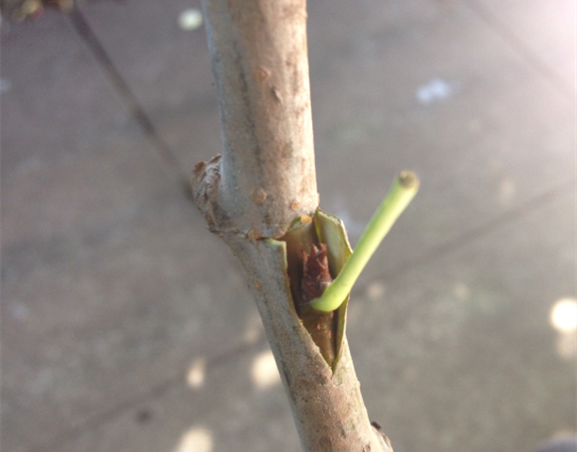
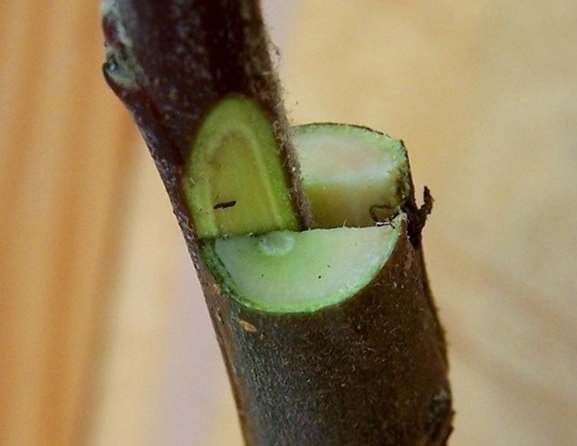
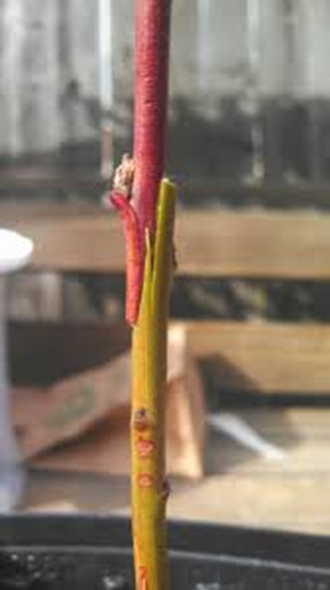
Tools and equipment.
Beware of overspending before you really get into it!
- A clean, sharp pair of Secateurs. All gardeners need a good quality pair of secateurs
- Grafting knife. A Stanley knife or snap-blade will do to start.
- Grafting tape: $5-6 for the basic stuff. Even a plastic bread-bag cut into strips can do the job
- Methylated spirits to sterilise tools. Re-use an empty spray bottle to apply. Some people use diluted bleach, but metho is much safer, environmentally sound, and doubles as hand sanitiser.
Selecting your grafting material
Selected scion is available online at various times. It ranges from a few dollars, up to hundreds of dollars for rare specimens. Expected to receive your scion/budwood Bagged, Tagged and with the cut ends Wax-sealed. Properly prepared material should remain viable for a couple of months, or longer, if kept in the crisper. Remember: If you enjoy some fruit from a friend’s tree, a piece of that tree will do nicely.
Scion should be clean and free of disease, thin (chopstick, up to pencil thickness), and covered in smooth light brown bark; not soft and green or gnarly old wood (citrus is an exception to this and is usually used green). Buds should be firm and plump, ideally with a single bud at each node rather than doubles, triples or clusters.
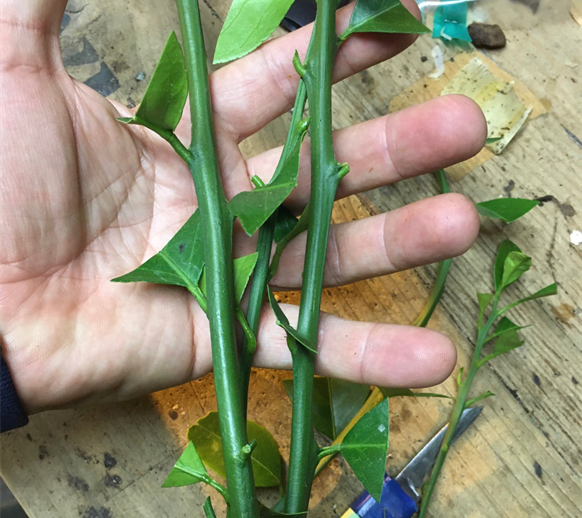
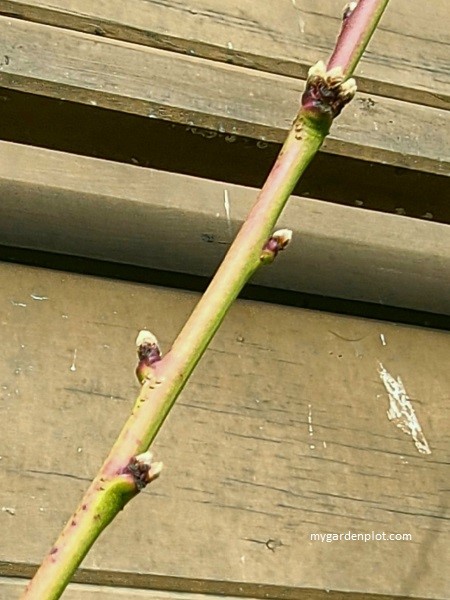
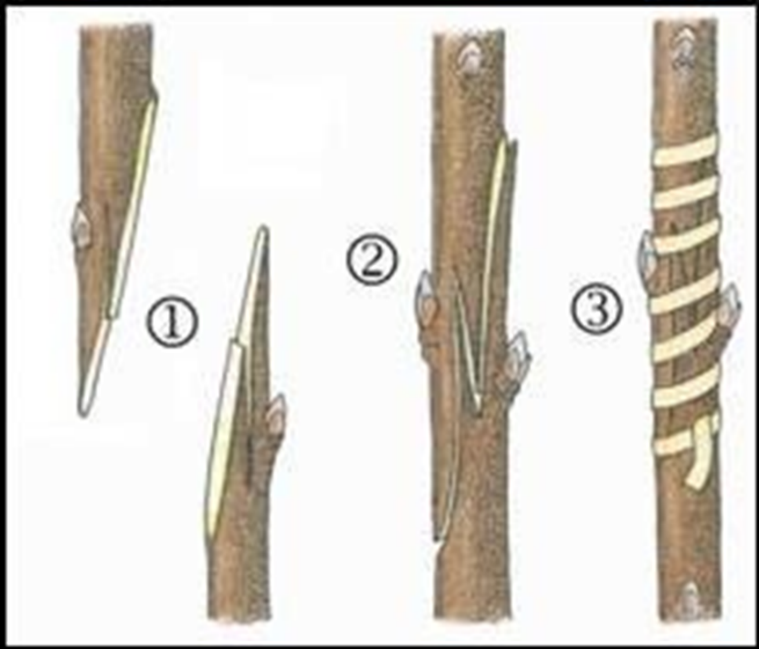
Whip and Tongue: an easy to learn, all-rounder grafting technique
Select your scion. Ensure the buds are facing upwards and then cut off the bottom section on a sharp angle. Turn the scion so the cut is facing upwards. Starting 1/3 of the way down from the top of the first cut, make a vertical cut down wards as shown to create the ‘Tongue’. Rock your knife gently to make the cut: Pushing hard to slice can result in a sudden reduction in fingers. Keep the cut scion wet while cutting the rootstock.
Cut the top of the rootstock off, about 100-200mm above soil level and then perform a matching cut.
Join the two pieces together by sliding the tongues under each other. It should be a firm fit. If the scion is thinner than the rootstock, you will need to match the cambium layer on one side, rather than in the middle. Securely tape the graft.
Some tricks of the trade
Match odd-sized grafts to one side to join cambium layers
Reduce scion length to two good buds
If your tape needs to be removed, wait at least a month
If using a bio or UV-degradable tape, you can tape the whole scion. Otherwise, cut scion just above a bud and seal the cut
Adding to established trees and Espalier – Whip & tongue grafting is also a reliable graft for adding more varieties to existing trees in your garden and for adding varieties to an espalier.
Further learning and resources
- https://werribeeparkheritageorchard.org.au/
- https://www.facebook.com/werribeeparkheritageorchard
- Youtube: JSacadura : @JSacadura.
Suppliers of rootstock in small quantities:
- Werribee Park Heritage Orchard
- Maple grove
- Citrus Men


